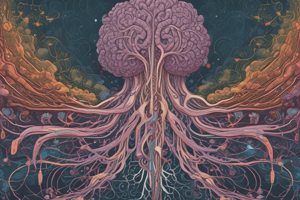Podcast
Questions and Answers
Which of the following drugs is classified as blocking neuronal Na+ channels?
Which of the following drugs is classified as blocking neuronal Na+ channels?
- Carbamazepine (correct)
- Vigabatrin
- Ethosuximide
- Topiramate
What is the mechanism of action for Phenobarbital?
What is the mechanism of action for Phenobarbital?
- Blocks excitatory transmitters
- Blocks T-type Ca2+ channels
- Blocks Na+ channels
- Enhances GABA inhibition (correct)
Which drug is primarily used for absence seizures?
Which drug is primarily used for absence seizures?
- Valproic Acid (correct)
- Lamotrigine
- Carbamazepine
- Phenytoin
What are the potential adverse effects of Phenytoin?
What are the potential adverse effects of Phenytoin?
Which of the following statements about first-generation antiepileptic drugs is NOT true?
Which of the following statements about first-generation antiepileptic drugs is NOT true?
Which of the following is an adverse effect associated with Carbamazepine?
Which of the following is an adverse effect associated with Carbamazepine?
What mechanism does Valproic Acid utilize to manage seizures?
What mechanism does Valproic Acid utilize to manage seizures?
Which of the following therapeutic uses is NOT associated with Ethosuximide?
Which of the following therapeutic uses is NOT associated with Ethosuximide?
Benzodiazepines are primarily used as a first-line treatment for which condition?
Benzodiazepines are primarily used as a first-line treatment for which condition?
Which of the following is a notable characteristic of Phenobarbital?
Which of the following is a notable characteristic of Phenobarbital?
Flashcards
Focal Seizures
Focal Seizures
Epileptic seizures that begin in a specific area of the brain, often with preserved awareness, sometimes accompanied by a loss of awareness, or even secondary generalization to the entire brain.
Generalized Seizures
Generalized Seizures
Epileptic seizures that begin in both hemispheres of the brain simultaneously, usually associated with loss of awareness.
GABA Inhibition
GABA Inhibition
A mechanism used by some antiepileptic drugs that enhances the inhibitory neurotransmitter GABA's action in the brain to reduce neuronal excitability.
Phenytoin (Diphenylhydantoin)
Phenytoin (Diphenylhydantoin)
Signup and view all the flashcards
T-type Calcium Channels
T-type Calcium Channels
Signup and view all the flashcards
Carbamazepine's Mechanism
Carbamazepine's Mechanism
Signup and view all the flashcards
Valproic Acid's Mechanism
Valproic Acid's Mechanism
Signup and view all the flashcards
Ethosuximide's Target
Ethosuximide's Target
Signup and view all the flashcards
Phenobarbital's Action
Phenobarbital's Action
Signup and view all the flashcards
Benzodiazepines' Mechanism
Benzodiazepines' Mechanism
Signup and view all the flashcards
Study Notes
Antiepileptic Drugs
- Antiepileptic drugs (AEDs) are used to treat epilepsy.
- Epilepsy is a disorder of the central nervous system characterized by recurrent seizures.
- Seizures involve abnormal, excessive electrical activity in the brain.
Types of Seizures
- Focal seizures:
- Preserved awareness.
- Lost awareness.
- Secondary generalization.
- Generalized seizures:
- Absence seizures.
- Tonic-clonic seizures.
- Myoclonic seizures.
Neurotransmitters and Epilepsy
- GABA (gamma-aminobutyric acid): Inhibits neuronal firing, reduced activity is associated with seizure activity.
- Glutamate and Aspartate: Excitatory neurotransmitters, increased activity is associated with seizure activity.
- NMDA receptors: Activated in response to glutamate/aspartate.
Classification of Antiepileptic Drugs (AEDs)
- Based on mechanism of action:
- Enhance GABA inhibition.
- Block excitatory transmitters.
- Block neuronal Na+ channels.
- Block T-type Ca2+ channels.
- Mixed mechanisms.
First Generation (Classic) AEDs
- Phenytoin (Diphenylhydantoin):
- Therapeutic uses: Tonic-clonic seizures, Class I antiarrhythmic.
- Adverse effects: CNS effects (nystagmus, diplopia, ataxia), liver effects (micr enz induction), blood effects (megaloblastic anemia), teratogenic effects (craniofacial anomalies, neural tube defects).
- Carbamazepine (Tegretol):
- Therapeutic uses: First line in focal seizures, second line in tonic-clonic seizures, trigeminal neuralgia.
- Adverse effects: CNS effects, liver effects, blood effects, teratogenic effects (craniofacial anomalies, neural tube defects), increase ADH secretion leading to hyponatremia and edema.
- Valproic acid (Depakine):
- Therapeutic uses: All types of seizures (focal and generalized), migraine prophylaxis.
- Adverse effects: CNS effects, liver effects, blood effects (neutropenia), teratogenic effects, alopecia, pancreatitis, fulminant hepatic toxicity.
- Ethosuximide:
- Therapeutic uses: First line for absence seizures.
- Adverse effects: GIT upset, headache, dizziness.
- Phenobarbital:
- Therapeutic uses: Tonic-clonic seizures, status epilepticus.
- Adverse effects: CNS effects, liver effects, megaloblastic anemia, teratogenic effects, tolerance and physical dependence, respiratory depression in toxic doses.
- Benzodiazepines:
- Therapeutic uses: Status epilepticus, febrile convulsions in children, absence seizures.
- Adverse effects: Tolerance and physical dependence, memory disturbances.
Second Generation (Newer) AEDs
- Vigabatrin:
- Therapeutic uses: Focal seizures, infantile spasms.
- Adverse effects: Irreversible visual loss.
- Lamotrigine:
- Therapeutic uses: All types of seizures (focal and generalized).
- Adverse effects: Skin rash and Stevens-Johnson syndrome.
- Topiramate:
- Therapeutic uses: Focal and generalized seizures, migraine prophylaxis.
- Adverse effects: Renal stones, weight loss, cleft palate.
- Levetiracetam:
- Therapeutic uses: All types of seizures (focal and generalized).
- Adverse effects: Very low.
Other AEDs (Adjuvant Drugs)
- Gabapentin and Pregabalin:
- Therapeutic uses: Adjuvant drugs in focal seizures, neuropathic pain.
- Adverse effects: Sedation, physical dependence.
- Tiagabine:
- Therapeutic uses: Adjuvant drugs in focal seizures.
- Adverse effects: GIT upset, dizziness.
Choice of AEDs
- First line, second line and third line of treatment is provided by seizure type.
Guidelines for AED use
- Start with one drug (monotherapy), if unsuccessful consider substituting another drug or using a combination of 2 drugs.
- Combination of valproic acid and lamotrigine use can have high risk of Stevens-Johnson's syndrome.
- Stop AEDs if seizure free for more than 2 years.
AEDs in Pregnancy and Breastfeeding
- AEDs can increase the risk of congenital defects in newborns.
- Prenatal use of folic acid is recommended to minimize the risk of neural tube defects.
- Breastfeeding is acceptable while taking most AEDs but not all.
Studying That Suits You
Use AI to generate personalized quizzes and flashcards to suit your learning preferences.




